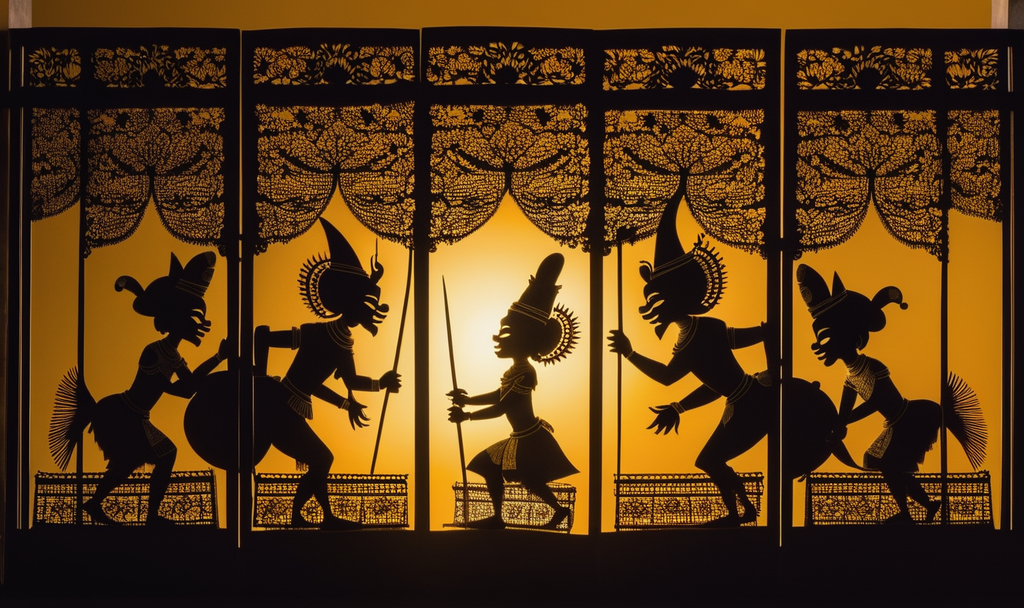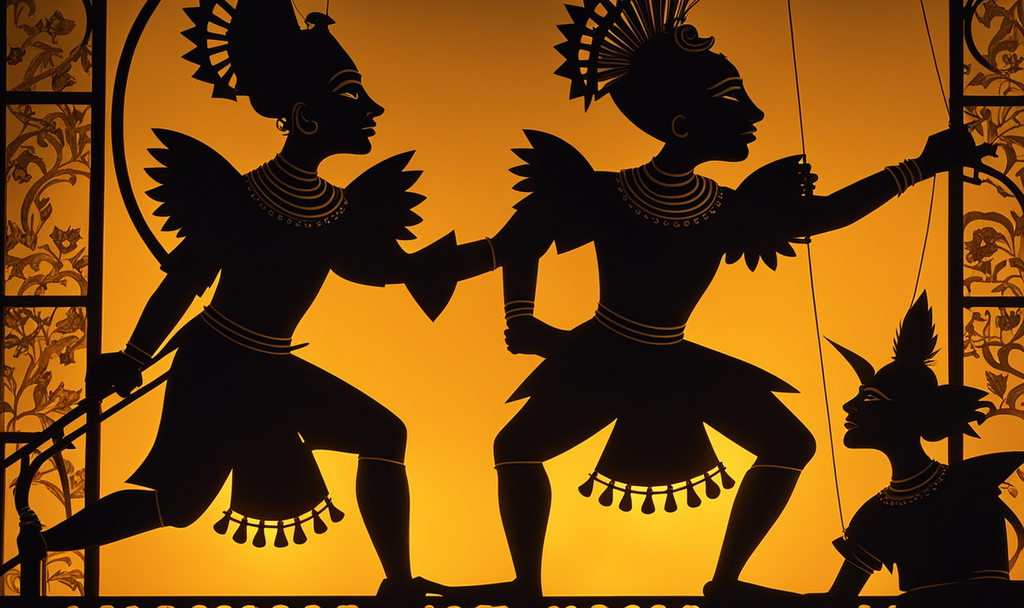There are many amazing art forms in Bali, but only one of them is a UNESCO World Heritage status art form and that is Wayang Kulit.
This is a traditional type of shadow puppet play that comes from the islands of Java and Bali in the Indonesian archipelago.
If you’re looking for some truly authentic local culture to enjoy on your holiday in Bali, why not take in a Wayang performance?
About Javanese Wayang Kulit

The art of Wayang Kulit is considered to be Javanese but for a long period of time, Bali and Java were under the same system of governance and many “Javanese” arts and traditions are also Balinese.
In a traditional Wayang Kulit performance the shadow puppet figures are behind a linen screen and then a light (using a coconut oil lamp traditionally but more recently an electric light has been substituted – this probably saves on setting wayang puppets alight, accidentally) is used behind them to create their shadows on the taut material in front of them.
Wayang Kulit is just one of several forms of shadow puppetry across Indonesian culture and others include wayang beber, wayang golek, wayang klitik, wayang wong and wayang topeng.
There is also a performance known as “wayang orang” or “human wayang” which is a dance form that showcases Hindu epics in a similar way to the Javanese shadow plays.
The Balinese version is the most famous form of shadow puppetry in Indonesia and this is because it is used as much for entertainment as it is to tell stories of good and evil for education.
What Does Wayang Kulit Mean?

The word “wayang” means “shadow” or “imaginary” and it comes from the original Javanese language, in Bahasa the current word would be “bayang”.
And the word “kulit” means either “skin” or “leather”. This refers to the materials that they use to make each shadow puppet.
The History Of The Art
There are two threads to the history of Wayang Kulit, the first is the history of the puppets and it appears that the first puppets were made in Java in the 10th century AD.
There are records of a puppet master and his creations performing at the start of the 11th century AD too.
It seems likely that this part of the art arose independently of the other thread.
That is the Indian folklore that brought about the epics of Hinduism. These were developed in the 8th century AD in India and became pervasive across much of Southeast Asia in the ensuing centuries.
By the 10th century AD, they would have been popular in both Java and Bali, however, by the period of 1200-1600 AD, Java had converted to Islam and the Balinese form of Wayang Kulit was outlawed in Java.
While you can see Javanese performances today of Wayang Kulit, they tend to be less forthrightly “Hindu” than those in Bali, which are more traditional.
One very recent development in the history of this art was that UNESCO (on the 7th of November, 2003) awarded the Wayang Kulit performance along with the Wayang Golek Performances the status of a Masterpiece of the Oral and Intangible Heritage Of Humanity.
In exchange for this status, Indonesia had to undertake to preserve this art for future generations.
Possible Origins Of The Wayang Performances

James R Brandon, a Professor of Asian Arts based at the University of Hawaii, says that the wayang show originates in Java and that this is clearly illustrated by its illustration of Javanese culture and its religious life.
This claim is supported by Dr. G A J Hazeu of the Dutch East Indies company.
Some scholars argue that the influence of Hindu epics that pervades many performances of Wayang Kulit means that it must have originated in India, but there is little tangible evidence for this and such epics are commonly found in performing arts throughout Southeast Asia which have arisen independently of India.
About The Wayang Kulit Figures

The wayang figures are elaborate puppets and they consist of a flat leather shadow puppet (the leather comes from a mixture of water buffalo hide and goat hide) which is mounted onto a set of bamboo sticks.
The most premium of the leather puppets are made using the hide of a young female buffalo which is then cured for up to a decade! And premium sticks are made from horn, rather than bamboo.
To make the puppets, an outline is scratched onto the hide and then a mallet is used to drive “tatah” through the surface to provide the shape for the rawhide.
This might sound simple, but it’s a hugely time-consuming process and it can take months to make one of the larger puppets!
Once the punching process is finished, the puppet is then painted with multiple layers of water-based paint and then accentuated with gold leaf (or bronze).
Finally, the sticks are attached to the figure and while bamboo sticks are easy to make, horn ones are not and it can take several days of a multi-step process to fashion each stick.
Where To See A Wayang Performance In Bali

The best place to see a Wayang Kulit Performance on the island is Oka Kartini in Ubud, Bali.
The performance is delivered in Indonesian language but they offer a pre-performance synopsis in English to help explain what’s going on and which characters are which.
It’s quite important to pay attention or the wayang stories can get quite confusing.
The complex musical styles from the gamelan orchestra provide an amazing backdrop to this cultural highlight of Java and Bali.
Address: Oka Kartini Shadow Puppet Performance and Gallery, Gg. Beji No.35, Ubud, Kecamatan Ubud, Kabupaten Gianyar, Bali 80571, Indonesia
What Is Wayang Kulit? What Is Balinese Wayang Kulit?
Wayang Kulit is a shadow puppet performance that is very popular in Bali and Java.
Is Wayang Kulit Malaysian?
No. Wayang Kulit performances are a unique form of shadow puppet plays and they are only found in Bali and Java.
However, Malaysia does have its own puppet arts too but they are distinct from those found in Indonesia.
What Is The Puppet In Wayang Kulit? What Puppets Does Wayang Kulit Make Use Of?
The puppet is made of leather and either horn or bamboo and it is decorated with water-based paint and gold leaf. These puppets are quite distinct from wooden puppets and take much longer to make.
Where Can I See The Puppet Show In Bali? Where Can I See Wayang Kulit In Bali?
The best place to see Wayang Kulit performances in Bali is the Oka Kartini in Ubud. You can find the address above.
What Is The Difference Between Nang Shadow Puppet And Wayang Kulit?
Nang or Nang Yai is a Thai form of shadow play and it is quite distinct from the Balinese and Javanese art of Wayang Kulit.
It is thought that Nang Yai originated in Java and changed to become uniquely Thai as the art form migrated across Southeast Asia.
How Old Is Indonesian Shadow Puppetry?
It’s impossible to be certain as to how old this art form is but there are references to wayang that go back to the year 840 AD in the literature and of a puppet show taking place in 903 AD in the Ancient Mataram Kingdom of Java.
Final Thoughts On Wayang Puppet Theatre
One of the most interesting and unique aspects of Balinese culture is the Wayang Kulit performances which are still held today.
No simple puppet show, these are highly coordinated retellings of Hindu epics that see a puppet master, a traditional orchestra and a supporting cast of singers bring the stories to life in incredible fashion.
If you have time to catch a performance while you’re in Bali, we recommend that you do, it’s a truly unique piece of Balinese culture.













